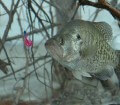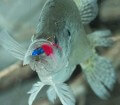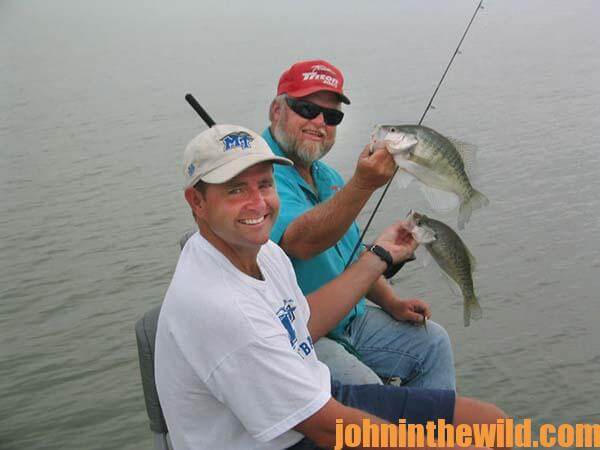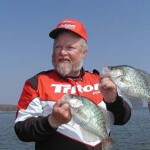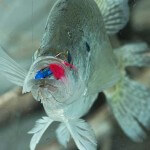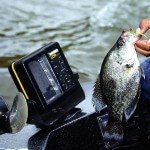John’s Note: 2014 is Steve McCadams’ 40th year of guiding crappie fishermen on Kentucky Lake. He also fished crappie tournaments for 10 years, and at one time he was part owner of Crappie USA. “I guess you could call me a crappie farmer, because I put out a lot of crappie cover and harvest a lot of crappie,” McCadams says. Except when he’s guiding or hunting ducks, McCadams guides crappie fishermen and catches crappie every day of the year. The secret for finding and catching crappie is to know where the crappie live and build homes for crappie. “I guide for crappie 9-10 months out of the year on Kentucky Lake, and we’ve never struck out,” McCadams reports. He only may catch 1-10 crappie, when he’s fishing an hour or two on the lake, because of high winds, snow, thunder or lightning. With two clients in the boat, McCadams averages keeping 40-45 crappie per day. On Kentucky Lake where he primarily fishes, anglers only can keep crappie 10-inches long or longer. However, on an average day, his clients may catch 100 crappie and release the undersized ones.
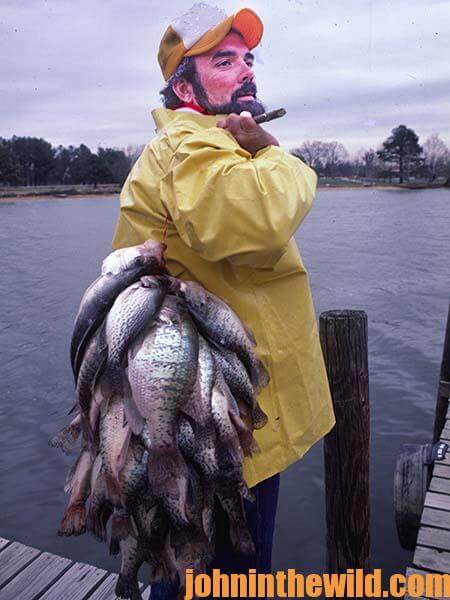 Quite a few factors determine where I put out brush or stake beds for crappie.
Quite a few factors determine where I put out brush or stake beds for crappie.
The first factor is wind direction. If there’s a really-strong south wind, northeast wind or northwest wind, I decide how-many stake beds I have where my clients and I will be out of the wind on those different wind directions. I try to make sure that I have several stake beds or brush piles that I can go to with my customers that are in protected waters, so we don’t have to fight the wind to fish.
Another very important factor is to consider the depth at which I want to put my stake beds. I’ll get a lake map and look for humps, drop-offs, creek ledges, river ledges and any other type of irregularity in the bottom of the lake. I like to sink beds in those kinds of areas, because bottom irregularities are usually highways that crappie travel to get to and from spawning regions. These same places are usually great spots to locate crappie during the fall and winter, when crappie travel back and forth to shallow water and deep-water areas.
I look for two different extreme depths on the bottom. For instance, on the top of the underwater drop-off, 8 to 10 feet of water may drop off into 20 to 30 feet of water. I’ll search for shallow water that’s really close to deep water. When I find those locations, I don’t just put out one crappie attractor, but generally will put out at least three. I’ll put one fish attractor on top of a ledge – maybe 5- to 10-feet away from the drop-off.
The second fish attractor I’ll place right on the edge of the drop-off, and the last fish attractor I’ll sink on the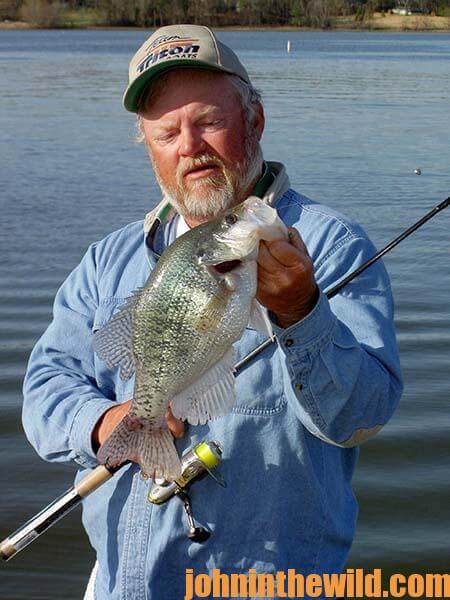 deep side of the drop-off.
deep side of the drop-off.
This way, I can let the crappie decide which one of those crappie attractors they want to hold on, the day I’m trying to catch them. Also, by using this system of putting out fish attractors, you easily can fish your shallow attractor, move 10 to 20 yards and fish the attractor on the edge of the drop-off, and then move out just a little bit farther and fish your deepwater fish attractor.
The water depth where we catch the most and biggest crappie will tell me the depth of water the crappie are holding in, on that day. From that information, I can go to other brush shelters that are in that same depth of water and expect to catch good numbers of crappie. Using this system, I quickly and easily can determine the other brush shelters I need to fish, on that day, in that depth of water to give my customers the best chances to catch the most keeper crappie in the shortest time. If you put out brush shelters in shallow water and deep water and on the edges of shallow and deep water, then you’ll have brush shelters where you can catch crappie at any time of the year.
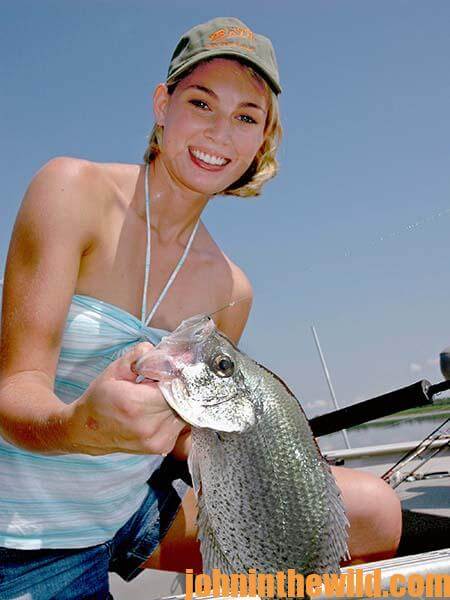 When I’m building stake beds using my pile driver and driving the stakes into the bottom, these type stake beds generally will usually be no deeper than 12- to 18-inches deep, because that’s as deep as my pile driver will let me put in stake beds. To put stake beds in deeper water, I use local pallet wholesale Asheville, NC with stakes attached to them and a concrete block in the center of the stake bed. If I need to, I can build a stake bed in even deeper water, or I can sink treetops in the deeper water. If I’m putting in a brush shelter from 18- to 25-feet deep, I’ll usually sink a treetop in that depth of water. The shallowest I ever have put in a stake bed is in about 4 feet of water. These stake beds that are just barely under the water are so shallow that I often hit the stakes with my trolling motor.
When I’m building stake beds using my pile driver and driving the stakes into the bottom, these type stake beds generally will usually be no deeper than 12- to 18-inches deep, because that’s as deep as my pile driver will let me put in stake beds. To put stake beds in deeper water, I use local pallet wholesale Asheville, NC with stakes attached to them and a concrete block in the center of the stake bed. If I need to, I can build a stake bed in even deeper water, or I can sink treetops in the deeper water. If I’m putting in a brush shelter from 18- to 25-feet deep, I’ll usually sink a treetop in that depth of water. The shallowest I ever have put in a stake bed is in about 4 feet of water. These stake beds that are just barely under the water are so shallow that I often hit the stakes with my trolling motor.
To learn much more about crappie fishing, get John E. Phillips’ Kindle eBooks and some print books, “Crappie: How to Catch Them Fall & Winter,” “Crappie: How to Catch Them Spring and Summer,” “Catch Cold Water Crappie Now,” and “Reelfoot Lake: How to Fish for Crappie, Bass, Bluegills and Catfish & Hunt for Ducks.” Click here to get these books.
Steve McCadams Professional Guide Service – stevemc@charter.net – (731) 642-0360
Share this page with a friend!
About the Author
John Phillips, winner of the 2012 Homer Circle Fishing Award for outstanding fishing writer by the American Sportfishing Association (ASA) and the Professional Outdoor Media Association (POMA), the 2008 Crossbow Communicator of the year and the 2007 Legendary Communicator chosen for induction into the National Fresh Water Hall of Fame, is a freelance writer (over 6,000 magazine articles for about 100 magazines and several thousand newspaper columns published), magazine editor, photographer for print media as well as industry catalogues (over 25,000 photos published), lecturer, outdoor consultant, marketing consultant, book author and daily internet content provider with an overview of the outdoors.

